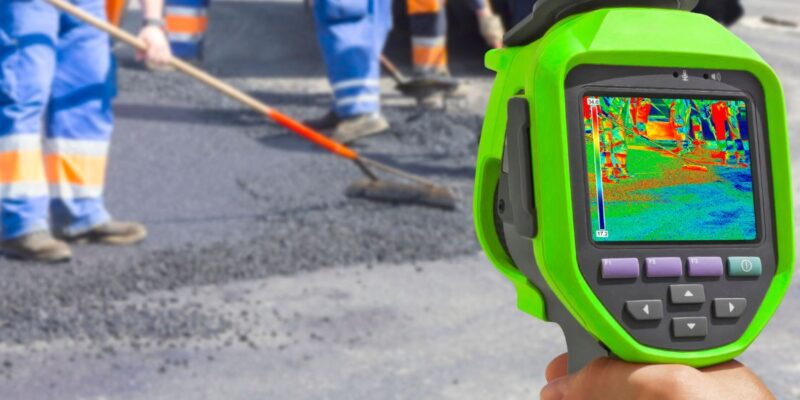Thermography is simply a type of imaging technology that visualizes the analysis of temperature differences across objects and surfaces. It is widely used in various fields such as building inspections, industrial maintenance, energy monitoring, medicine, and more. At the core of this technology lies the thermal camera, which is an essential tool for capturing and interpreting thermal images.
Within this article, we will explore the basic principles of thermography to understand exactly how thermal cameras work.
Basic Principles of Thermography
Thermography is based on the fundamental principle that all objects emit infrared radiation (IR) based on their temperature. Thermal cameras are designed to detect and measure this IR radiation that is invisible to the human eye.
The entire IR spectrum is split into other different ranges, such as near-infrared (NIR), mid-infrared (MIR), and far-infrared (FIR). Thermal cameras are known to be typically sensitive to the mid-infrared range, which corresponds to the 3 to 5 or 8 to 14 microns wavelengths.
Functioning of Thermal Cameras
Thermal cameras are equipped with an infrared sensor that converts IR radiation into an electrical signal, and then into a thermal image. The most commonly used sensors are microbolometer sensors, which consist of an array of microstructures sensitive to heat. When IR radiation hits these microstructures, they generate an electrical signal proportional to the temperature of the corresponding area in the image.
The electrical signal sent from the sensor is then amplified and processed by the camera’s electronics resulting in the production of a thermal image. The image is typically displayed using a color palette, where each color represents a specific temperature range. For example, warm colors such as red and yellow represent areas with higher temperatures, while cooler colors like blue and green may represent lower temperatures.
Thermal cameras detect temperature differences between objects and surfaces rather than directly measuring the temperature. They are calibrated using emissivities, which are specific properties of each material that affect the amount of infrared radiation they emit. Emissivity is a crucial factor in interpreting thermal images, as incorrect values can lead to inaccurate measurements.
Applications of Thermal Cameras
Thermal cameras are widely used in various fields. They are particularly useful for building inspections, where they can detect insulation defects, air leaks, moisture problems, and thermal bridging. This provides a quick and non-destructive evaluation of the energy efficiency of structures.
Moreover, these cameras are employed for inspecting electrical and mechanical systems, allowing the identification of overheating, hotspots, and operational issues before they become critical.
In the industry, thermal cameras are used for preventive maintenance, leak detection, monitoring manufacturing processes, detecting welding defects, locating faulty circuits, and many other applications.
Thermal cameras also find applications in security, enabling intrusion detection, monitoring high-risk areas, and fire prevention.
In the medical field, thermal cameras are specifically used to detect the variation in body temperature, which can aid in identifying certain problems like infections, inflammations, muscle injuries, and other medical conditions.
These cameras are also used for scientific research purposes to study thermoregulation, chemical reactions, biological processes, and many other aspects.
Important Factors to Consider When Using Thermal Cameras
When using thermal cameras, several factors need to be taken into account to ensure accurate and reliable results.
Calibration of the camera is a key factor. Calibration ensures that the camera is properly calibrated and adjusted to produce accurate thermal measurements. Regular calibration of thermal cameras is necessary to ensure precise measurements. This involves referencing a known temperature source to adjust the camera’s settings based on environmental variations.
Another important factor is the camera’s focal distance. The distance between the camera and the object being inspected affects the resolution and accuracy of thermal measurements. Choosing an appropriate focal distance is crucial based on the object’s size and the required precision.
Emissivity is also a critical factor. Emissivity is a physical property of a material that measures its ability to emit infrared radiation (IR). Each material has a different emissivity, which influences the amount of IR radiation it emits. It is important to know the emissivity of the target material and properly set it on the thermal camera for accurate measurements.
Lastly, environmental conditions play a crucial role. These factors include the environment’s lighting, reflection, air currents, and the presence of any external heat sources that could affect the accuracy of thermal measurements. It is essential to minimize these interferences and follow best practices to obtain reliable results.
Optimize Your Thermography Needs With Scan Plus Tech
Thermal cameras are valuable tools for thermography, allowing the visualization and analysis of temperature differences in various applications. By understanding the basic principles of thermography and the functioning of thermal cameras, it is possible to fully harness their potential.
In this article, we have explored the fundamental principles of thermography and how thermal cameras convert infrared radiation into thermal images. We have also discussed common applications of these cameras and important factors to consider when using them.
If you are in need of professional thermography services for inspection, maintenance, or surveillance needs, trust Scan Plus Tech. With their extensive expertise and state-of-the-art equipment, Scan Plus Tech offers high-quality thermography services, providing accurate and reliable information to support your decision-making.
Contact Scan Plus Tech now to learn more about their thermography services and discover how they can meet your specific needs. Improve your efficiency, safety, and performance with professional-grade thermography offered by Scan Plus Tech.

